Subjects:
- General info about the brake booster
- Operation of the vacuum brake booster
- Vacuum connection and pump of the vacuum brake booster
- Hydraulic brake booster
General info about the brake booster:
Vacuum brake boosters are used on almost all passenger cars. With the help of the brake booster, the driver has to press the brake pedal less forcefully to obtain the same braking effect than with a car without a brake booster. A brake booster helps the pistons in the master cylinder to shift. The brake booster is located in the engine compartment, connected by a rod to the brake pedal (see the right rod in the picture). The master cylinder is mounted directly on the brake booster (left side of the picture). The pressure exerted on the brake pedal is amplified approximately 3 to 4 times.
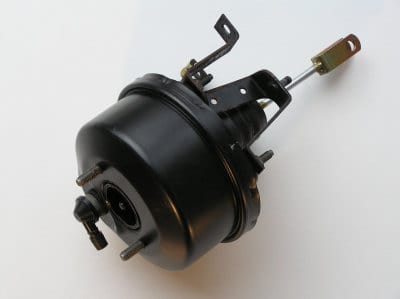
Operation of the vacuum brake booster:
rest position:
The engine runs, but there is no braking. There is underpressure in both the left and right side of the actuator cylinder. Underpressure prevails in the blue colored rooms. The air is sucked out of the exciter via the vacuum connection. This is done through a connection to the intake manifold, or through a separate vacuum pump. The outside air pressure (green) is cut off from the exciter. The spring pushes the working piston as far to the left as possible.
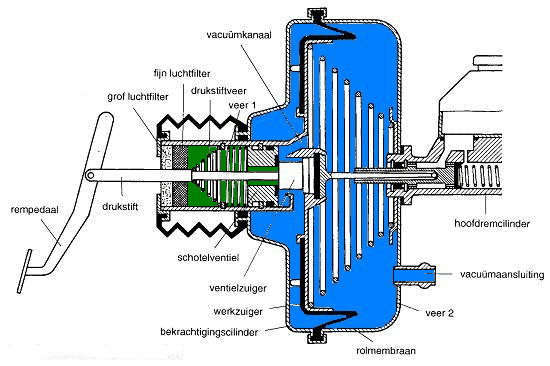
Start braking:
When the brake pedal is actuated, the valve piston moves to the right. This releases from the poppet valve, so that the left side of the actuation cylinder is partly filled with outside air pressure (green). The negative pressure (blue) disappears. To the left of the working piston there is now a pressure that is lower than the outside air pressure, but higher than the vacuum. The validation is therefore not yet maximum at the moment.
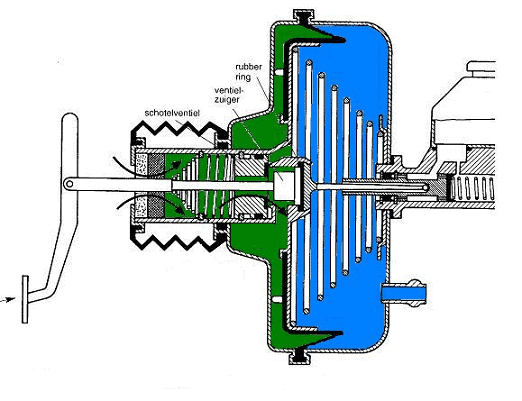
Maximum excitation:
The brake pedal is further depressed. The connection between the valve piston and the poppet valve remains open, filling the left side with even more outside air pressure. The maximum outside air pressure now prevails on the left side of the exciter and a maximum negative pressure can be found on the right side. When the brake pedal is depressed to the maximum, the spring in the brake booster is also depressed. This ensures maximum braking power.
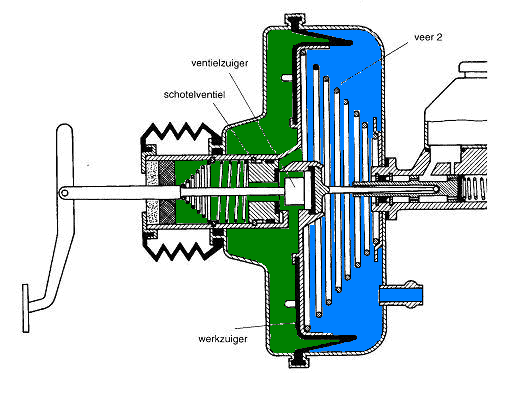
When the brake pedal is released, the spring in the brake booster pushes the working piston to the left again. The valve piston will rest against the poppet valve again, releasing the underpressure opening. The outside air pressure disappears again from the left side of the actuation cylinder and a negative pressure is created again. The brake booster is now back in the rest position. The situation as shown in figure 1 now applies again.
Vacuum connection and pump of the vacuum brake booster:
The required negative pressure (vacuum) for a vacuum brake booster is often obtained by the engine vacuum in a petrol engine. A hose runs from the brake booster to the intake manifold. Because an underpressure prevails in the intake manifold, underpressure is also extracted from the exciter. When the engine is turned off and the brake pedal is pumped several times, the pedal will feel hard. This is because all the vacuum has disappeared from the brake booster. When the engine is started again, the pedal will drop again and it will be possible to press further. It must therefore always be taken into account when a vehicle is towed; in the car with the engine not running, 3 to 4 times as much force will have to be exerted on the pedal. Also, the power steering will not work. It is therefore wise to drive slowly.
It is possible that the pedal feels hard immediately after switching off the engine; it seems as if the vacuum immediately falls away. This could be due to a ruptured vacuum hose between the brake booster and the engine, or a faulty return valve in the hose. This is usually a round piece of plastic between 2 parts of the hose.
If the relevant hose is torn, it must be replaced as soon as possible. If it further tears or breaks, the complete power brakes will fail.
There are two different vacuum pumps, namely the vane pump and the diaphragm pump. The vane pump is also called the tandem pump or the vacuum pump. The operation and application of these pumps is described on the page vacuum pump.
Hydraulic brake booster:
Hydraulic brake boosters are rarely used in passenger cars. That's why this page won't go into too much detail. With hydraulic brake boosters, the force applied to the master cylinder is supported by fluid pressure. The hydraulic brake booster is located between the brake pedal and the master cylinder.
In some systems, the power brakes system (by means of the accumulator) is combined with the power steering. In the image below you can see by the colors which pipes belong to which components. Hydraulic oil or ATF (Automatic Transmission Fluid) is used in all visible pipes. In the system with the master cylinder and brake lines to the brake calipers/drums, regular brake fluid is used. The fluid of the brake booster and master cylinder is therefore different and must of course not be mixed with each other.
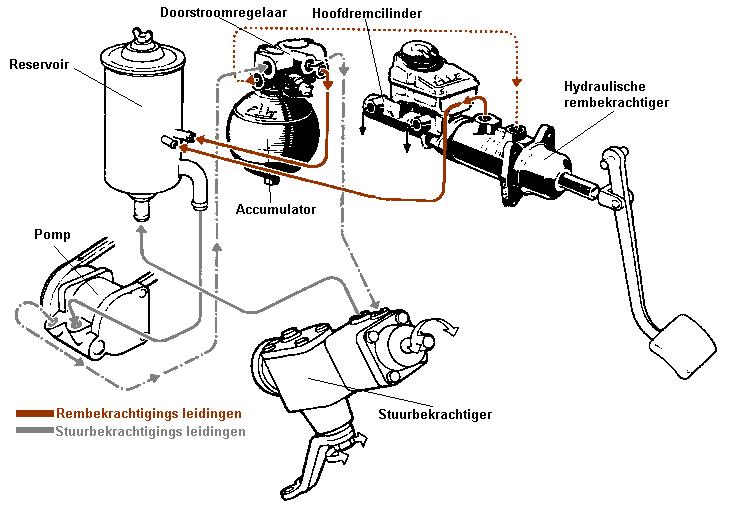
Hydraulic Power Brake System Components:
- Hydraulic brake booster: The supplied oil will support the pedal force in this brake booster.
- Master cylinder: This is where the pressure build-up of the brake fluid begins.
- Pump: The pump (driven by belt or electric motor) provides the required pressure. In these types of systems, the same pump is often used for multiple systems, such as power steering, height control, hydropneumatic suspension, etc. Other systems use a separate pump.
- Reservoir: The hydraulic oil or ATF is stored in the reservoir.
- Accumulator: The oil is stored in the accumulator at a high pressure of 36 to 57 bar.
- Flow Controller: This keeps the accumulator filled and regulates the flow of the brake booster and power steering fluid.
